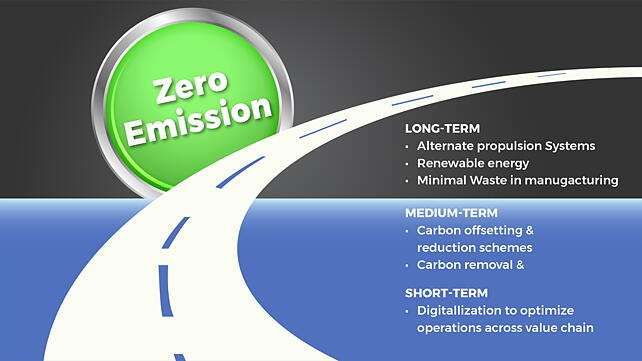
The initiatives around digitalisation, carbon offsetting, and partial blends of sustainable aviation fuels (SAF) will enable the aviation industry to optimise existing resources and contain the overall environmental impact to a certain level. These efforts will be the key focus areas towards sustainability in commercial aviation over the short and medium terms. But these efforts will still not halt continued emissions from the industry.
The major emission area is the fossil-fuel-dependent engines and is a key target area for emission-conscious stakeholders. The industry is highly reliant on reliable jet engines that have a stable ecosystem built around them. The process to transition to an alternate propulsion system that is greener for experimental aircraft, or a few aircraft will be a highly complex process requiring high levels of investment and collaboration.
The complexity and challenges will increase manifold as the aviation industry attempts to scale these different systems to most of the global commercial fleet in service. The scope of operations in which experimental aircraft with alternate propulsion systems will operate in the current scenario are short-haul cargo operations, and there are several test runs happening in the field.
The regulatory bodies – Federal Aviation Administration (FAA) and European Aviation Safety Agency (EASA) – are also cooperative with this shift towards a cleaner future and are providing guidelines and special certificates for ensuring continuous innovation in a highly secure environment.
Clean Energy Across the Operational Ecosystem
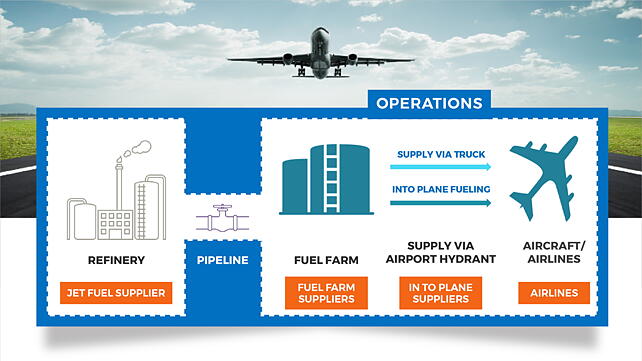
To facilitate the transition to cleaner aircraft, the other stakeholders (jet fuel suppliers, fuel farm suppliers, and airlines) mentioned in Exhibit 3, will also need to transition to processes that will ensure high reliability in operations. Also, they need to ensure minimal emissions in their activities to achieve a completely clean aviation industry.
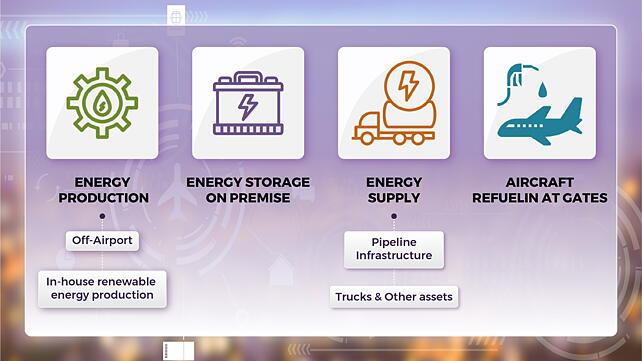
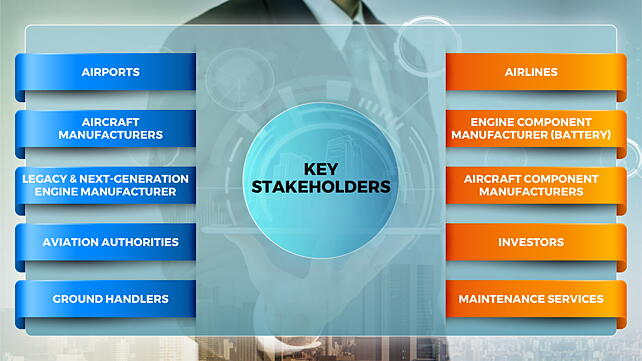
Potential Options for Large-Scale Adoption
Electric
Frost & Sullivan estimates that advanced battery packs with a high power-to-weight ratio will be mass-produced in the current decade. The sustainability benefits accelerate meeting emission benchmarks. A significant reduction in fuel costs and potential reduction in complexities and costs of maintenance are some key factors that will potentially lead to the adoption of electric aircraft.
Hybrid-electric aircraft powered by a combination of traditional jet fuel and electric motor enables the industry to gradually develop all-electric aircraft in a phased manner. Currently, these aircraft have a higher range than all-electric aircraft. All-electric aircraft, currently in development are expected to be ready for large-scale deployment by the end of this decade, are of smaller capacity and operable on shorter, regional routes.
The Urban Air Mobility (UAM) market will be a key driver for electrically-propelled aircraft. Several prototypes and designs for passenger and cargo transportation drones are developed around electric propulsion. As the technological and operational maturity of these vehicles improves, the operational costs and individual emissions will be reduced.
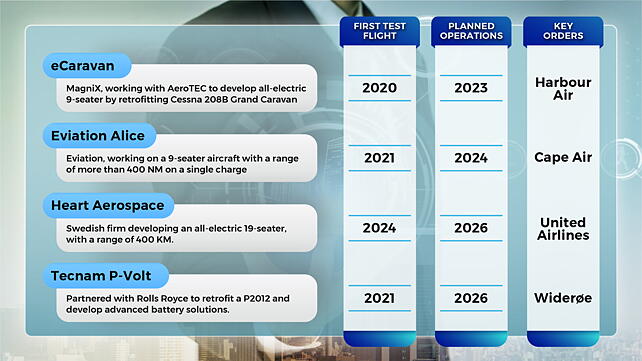
The parallel improvements in battery technology will enhance the range and load factor of these drones. These improvements will ensure that it can compete with traditional aircraft, especially the turboprop aircraft having an average capacity of 70-80 passengers and operating on regional and short-haul commercial airliner routes.
Some key players in this segment and their current status are mentioned in Exhibit 5.
Hydrogen
Frost & Sullivan estimates that aircraft powered by hydrogen will only enter the market at the end of this decade (2028 and beyond).
Hydrogen-powered aircraft will utilise hydrogen as a fuel by either combustion within a hydrogen-based propulsion engine, or the power generated can be utilised to power another propulsion system, like an electric engine. Hydrogen has a gravimetric energy density that is much higher than that of traditional jet fuel. It can also be generated directly from renewable energy reducing climate impact significantly and improving cost economics owing to synergies with other hydrogen-adopting sectors.
Hydrogen requires being compressed or turned into liquid hydrogen for its commercial utilisation. Due to its extreme gravimetric energy density and thermal storage characteristics, the volume to be carried on the flight also becomes significantly higher than current standards. This is a key challenge for the large-scale adoption of hydrogen as a viable option.
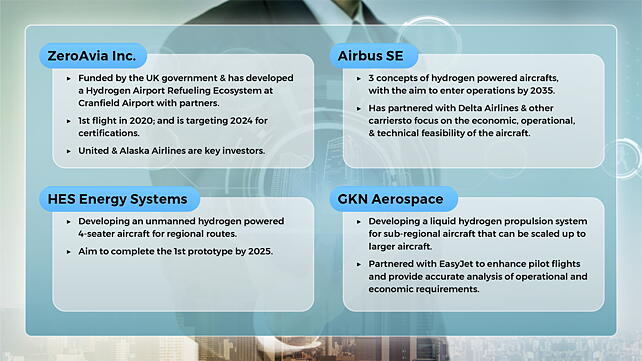
Retrofitting existing aircraft with hydrogen propulsion systems is already in the prototype phase. But, it will take more time than electric aircraft to gain maturity and expand into major airlines' fleets.
Some key players in this segment and their current status are mentioned in Exhibit 6.
Sustainable Aviation Fuel (SAF)
The European Union (EU) is a major champion of this fuel and has mandated that regional airports be supplied with at least 2% of SAF by 2025. The authorities are clear on their strategy to increase SAF adoption by increasing the mandatory blend levels at certain time intervals. Countries like Sweden have developed their own SAF strategies and mandates. Other regions or countries do not have a homogenous body developing and focusing their efforts on SAF adoption. Other industry collaborations are leading the development and adoption of SAF, for example, World Economic Forum’s (WEF) Clean Skies for Tomorrow Coalition, which aims to achieve net-zero emissions in aviation by 2050.
The key challenge facing SAF adoption is its high price. Blending costly SAF with jet fuel, whose costs are accelerating due to crude oil supply challenges and geopolitical crisis, will enhance the operating costs for airlines that usually operate on razor-thin margins.
SAF adoption will face high competition from the maturity of electric and hydrogen aircraft that will potentially enter into large-scale operations. But, SAF-powered aircraft will have an edge over other propulsion systems in the long-range routes, whereas others will require much higher technological innovation and maturity to support the longer-range.
Aircraft Manufacturing and Maintenance
New materials, cleaner raw material procurement techniques, efficient waste management systems, advanced data analysis to streamline manufacturing processes, transition to cleaner energy sources, additive manufacturing techniques, and offsetting unavoidable and hard-to-abate emissions are some of the key areas that aircraft manufacturers will focus on to ensure net-zero emissions.

The sustainability efforts and net-zero emissions target will proliferate to the component manufacturers, who will be incentivised to transition to cleaner manufacturing processes by the larger commercial aircraft manufacturers to reduce emissions in their processes. Long investment cycles and long-term operational life cycles of aircraft make it difficult for the manufacturers to adopt high-investment changes to their processes.
The aircraft maintenance sector lags behind other aviation segments in digitalisation and sustainability investments. Over the long term, this sector will face changes due to the drastic changes in aircraft structures and maintenance procedures. Digitalisation of existing processes, predictive capabilities, and real-time data availability will ensure the shift towards greener processes.
Conclusion
The journey towards net-zero emission will face several challenges as the overall industry and surrounding macro parameters evolve, but aviation along with other industries must ensure they stick to this path towards a greener earth. Harmful emissions, since the Industrial Revolution, have caused significant damage to our planet. The responsibility falls on individual industries to contain emissions and extract environment-harming substances before the impact becomes irreversible.
Note: This is the final article in the four-part article series by Frost & Sullivan on sustainability in the aviation industry.
About the Author: Abhilash Abraham is Senior Research Analyst, Aerospace & Defense Practice at Frost & Sullivan.